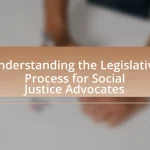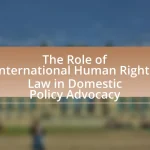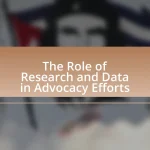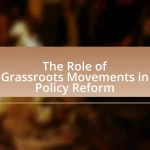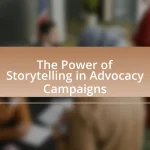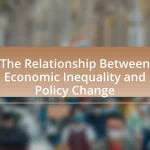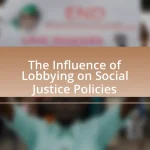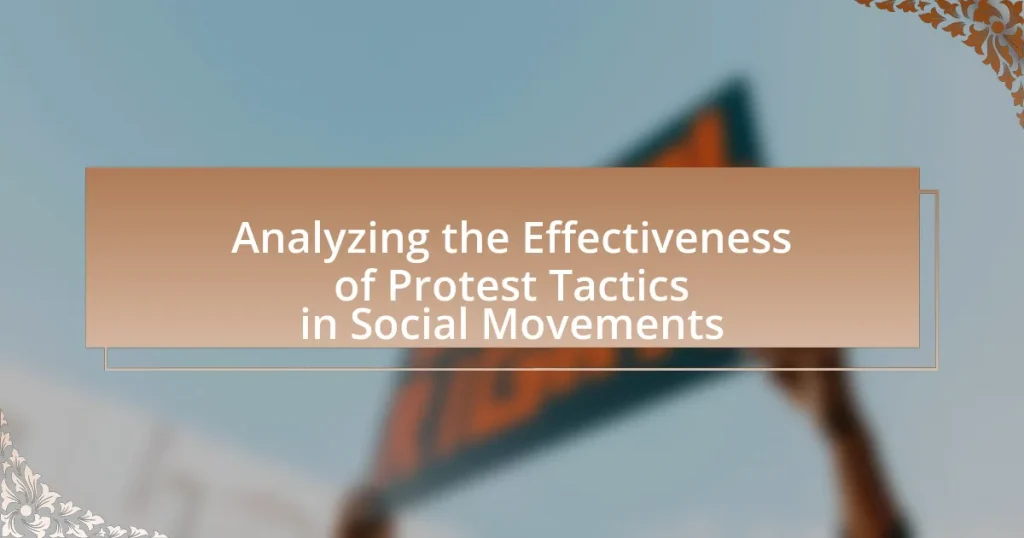The article focuses on analyzing the effectiveness of protest tactics in social movements, highlighting key methods such as marches, sit-ins, strikes, and online activism. It examines how different tactics vary in their approach, objectives, and effectiveness, particularly emphasizing the distinction between nonviolent and violent methods. Factors influencing the selection of tactics, including political context and public perception, are discussed, along with the challenges movements face in implementing these strategies. The article also evaluates the criteria for measuring the success of protest tactics and the role of coalition-building in enhancing their effectiveness.
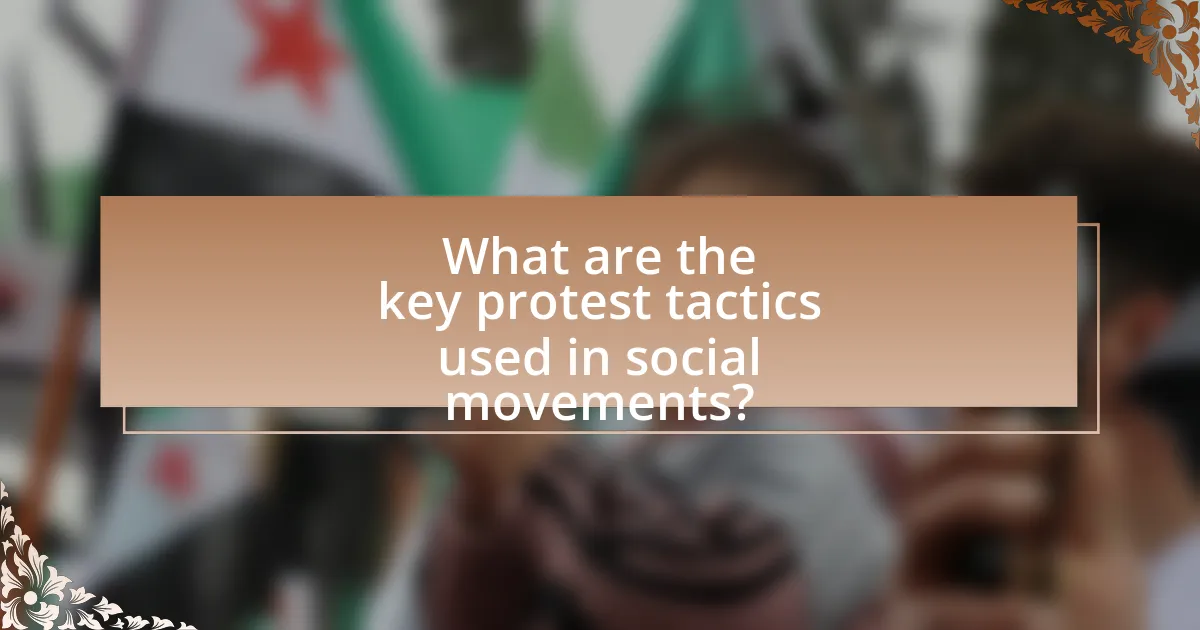
What are the key protest tactics used in social movements?
Key protest tactics used in social movements include marches, sit-ins, strikes, and online activism. Marches mobilize large groups to demonstrate solidarity and raise awareness, as seen in the Civil Rights Movement’s March on Washington in 1963, which drew over 250,000 participants. Sit-ins, such as those during the Greensboro sit-ins in 1960, disrupt normal activities to challenge segregation and demand change. Strikes, like the 1936-1937 Flint Sit-Down Strike, leverage workers’ power to negotiate better conditions. Online activism, exemplified by movements like #BlackLivesMatter, utilizes social media to organize, spread information, and engage a global audience. Each tactic has proven effective in drawing attention to social issues and influencing public policy.
How do different protest tactics vary in their approach?
Different protest tactics vary in their approach primarily through their methods of engagement, target audience, and intended outcomes. For instance, direct action tactics, such as sit-ins or blockades, aim to disrupt normal activities to draw immediate attention to an issue, while more traditional methods like petitions or lobbying focus on influencing policymakers through formal channels. Research indicates that nonviolent protests, such as marches and rallies, often garner broader public support and media coverage compared to violent tactics, which can alienate potential allies and provoke backlash. A study by Chenoweth and Stephan in “Why Civil Resistance Works” highlights that nonviolent movements are more likely to achieve their goals, demonstrating the effectiveness of varying approaches in protest tactics.
What are the most common non-violent protest tactics?
The most common non-violent protest tactics include sit-ins, marches, boycotts, and civil disobedience. Sit-ins involve occupying a space to disrupt normal activities, as seen in the American civil rights movement. Marches, such as the 1963 March on Washington, mobilize large groups to demonstrate solidarity and raise awareness. Boycotts, like the Montgomery Bus Boycott, aim to economically pressure entities by refusing to purchase their goods or services. Civil disobedience entails deliberately breaking laws to highlight injustice, exemplified by Gandhi’s salt march in 1930. These tactics have historically proven effective in drawing attention to social issues and prompting change.
How do violent protest tactics differ in their objectives?
Violent protest tactics differ in their objectives primarily based on the intended outcomes and the messages they aim to convey. For instance, some violent protests seek to instigate immediate governmental change or policy reform through disruption, while others may aim to provoke a reaction from authorities to highlight systemic injustices. Historical examples include the 1968 Democratic National Convention protests, where violent tactics were employed to draw attention to anti-war sentiments, contrasting with the 1999 Seattle WTO protests, which used property destruction to challenge globalization policies. These differing objectives reflect the strategic choices made by protestors based on their specific goals and the socio-political context in which they operate.
Why do social movements choose specific protest tactics?
Social movements choose specific protest tactics to maximize their visibility and impact while aligning with their goals and values. These tactics are often selected based on factors such as the political context, the target audience, and the desired outcomes. For instance, nonviolent protests, like marches or sit-ins, are frequently employed to attract media attention and public sympathy, as seen in the Civil Rights Movement, where tactics like the 1963 March on Washington effectively highlighted racial injustices. Additionally, social movements may adopt disruptive tactics, such as blockades or occupations, to create urgency and pressure decision-makers, as demonstrated by the Occupy Wall Street movement, which aimed to challenge economic inequality. The choice of tactics is thus a strategic decision influenced by the movement’s objectives, the sociopolitical environment, and the potential for achieving change.
What factors influence the selection of protest tactics?
The selection of protest tactics is influenced by factors such as the goals of the movement, the political context, the target audience, and the resources available. Movements aiming for specific policy changes may choose tactics that directly engage policymakers, while those seeking broader social change might opt for more visible, public demonstrations. The political context, including government response and public sentiment, shapes the perceived effectiveness of various tactics. Additionally, the target audience influences the choice; for instance, tactics may be tailored to resonate with specific demographics or to attract media attention. Resources, including funding, organizational capacity, and access to technology, also play a critical role in determining which tactics are feasible and likely to succeed.
How does the political context affect tactical choices?
The political context significantly influences tactical choices in social movements by shaping the strategies activists adopt to achieve their goals. For instance, in repressive political environments, movements may opt for nonviolent tactics to avoid harsh crackdowns, as seen in the Civil Rights Movement in the United States, where leaders like Martin Luther King Jr. emphasized peaceful protests to garner public sympathy and support. Conversely, in more open political contexts, movements might employ a wider range of tactics, including direct action or civil disobedience, as demonstrated by the Occupy Wall Street movement, which utilized encampments and public demonstrations to challenge economic inequality. The effectiveness of these tactics is often contingent upon the prevailing political climate, public sentiment, and the level of state repression, which can either facilitate or hinder the movement’s objectives.
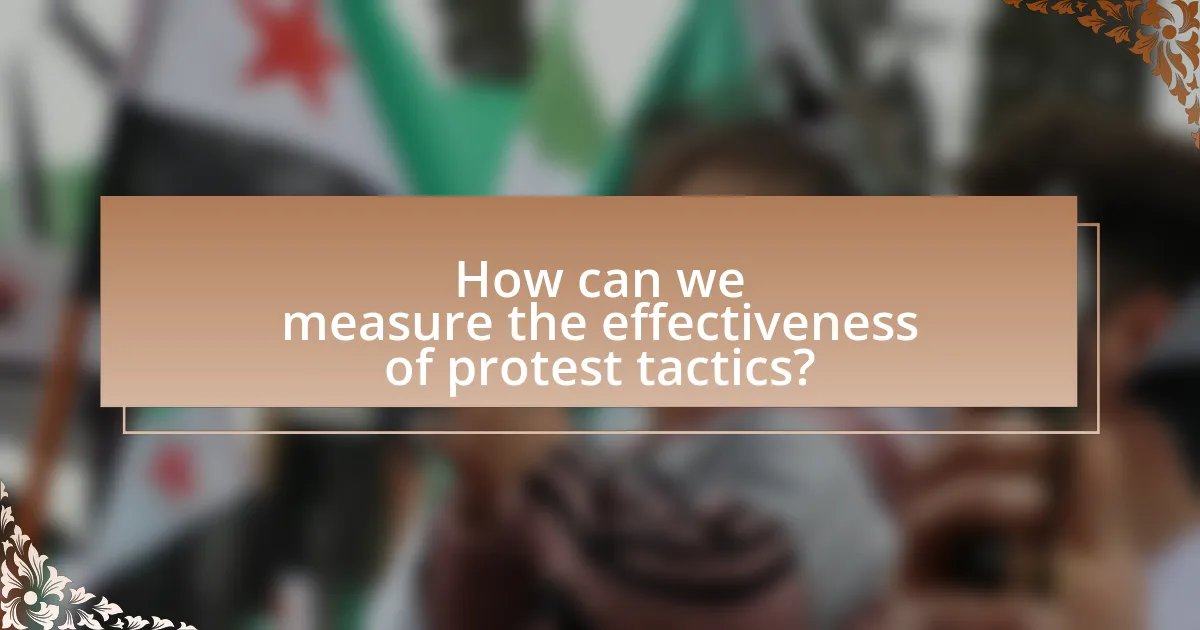
How can we measure the effectiveness of protest tactics?
The effectiveness of protest tactics can be measured through various quantitative and qualitative metrics, including changes in public opinion, policy outcomes, and media coverage. For instance, surveys can assess shifts in public sentiment before and after protests, while legislative changes can indicate successful advocacy efforts. Additionally, analyzing media coverage can reveal the visibility and framing of the protest, which impacts public perception. Historical examples, such as the Civil Rights Movement, demonstrate that sustained protests led to significant legislative changes, such as the Civil Rights Act of 1964, highlighting the correlation between protest tactics and tangible outcomes.
What criteria are used to evaluate the success of protest tactics?
The success of protest tactics is evaluated based on criteria such as visibility, impact on public opinion, policy change, and participant engagement. Visibility refers to the extent to which the protest captures media attention and public awareness, as seen in the global reach of movements like Black Lives Matter, which significantly influenced discussions on racial justice. Impact on public opinion is measured through shifts in societal attitudes, often assessed via polls before and after protests, demonstrating how tactics can reshape narratives. Policy change is a critical indicator, where successful protests lead to legislative or institutional reforms, exemplified by the Women’s March contributing to increased political participation among women. Lastly, participant engagement assesses the level of involvement and mobilization within communities, indicating the sustainability and grassroots support of the movement. These criteria collectively provide a framework for analyzing the effectiveness of protest tactics in achieving their objectives.
How do we assess public engagement and support?
Public engagement and support are assessed through surveys, social media analysis, and participation metrics. Surveys gauge public opinion on specific issues, while social media analysis examines engagement levels, sentiment, and reach of protest-related content. Participation metrics track attendance at events and involvement in campaigns, providing quantitative data on support levels. For instance, a study by the Pew Research Center found that 70% of Americans support peaceful protests, indicating strong public backing for social movements.
What role does media coverage play in measuring effectiveness?
Media coverage serves as a critical metric for measuring the effectiveness of protest tactics in social movements. It influences public perception, mobilizes support, and can lead to policy changes by amplifying the movement’s message. For instance, studies have shown that increased media attention correlates with higher public engagement and awareness, as evidenced by the significant media coverage during the Black Lives Matter protests in 2020, which resulted in widespread discussions on racial justice and police reform. This demonstrates that the extent and nature of media coverage directly impact the perceived success and effectiveness of social movements.
What are the short-term and long-term impacts of protest tactics?
Protest tactics have both short-term and long-term impacts on social movements. In the short term, protest tactics can raise awareness, mobilize supporters, and pressure authorities to respond to specific grievances, as evidenced by the Women’s March in 2017, which drew millions globally and highlighted issues like women’s rights and healthcare. Long-term impacts include the potential for systemic change, shifts in public opinion, and the establishment of new norms, as seen in the Civil Rights Movement, where sustained protests led to significant legislative changes like the Civil Rights Act of 1964. These impacts demonstrate how protest tactics can effectively influence both immediate outcomes and broader societal transformations over time.
How do immediate outcomes differ from sustained changes?
Immediate outcomes refer to the short-term effects of protest tactics, such as increased media attention or immediate policy changes, while sustained changes involve long-term transformations in societal norms, policies, or behaviors resulting from ongoing activism. For example, the Civil Rights Movement achieved immediate outcomes like the desegregation of public spaces, but sustained changes included the establishment of lasting legal protections against discrimination, as seen in the Civil Rights Act of 1964. This distinction highlights that immediate outcomes can catalyze sustained changes, but the latter requires continued effort and engagement over time.
What examples illustrate the long-term effectiveness of specific tactics?
The long-term effectiveness of specific protest tactics is illustrated by the Civil Rights Movement’s use of nonviolent resistance, which led to significant legislative changes such as the Civil Rights Act of 1964 and the Voting Rights Act of 1965. This approach not only garnered widespread public support but also shifted societal attitudes towards racial equality, demonstrating that sustained nonviolent tactics can achieve lasting political and social change. Additionally, the anti-apartheid movement in South Africa effectively utilized international sanctions and grassroots mobilization, culminating in the end of apartheid and the establishment of a democratic government in 1994. These examples underscore how strategic, nonviolent tactics can produce enduring outcomes in social movements.
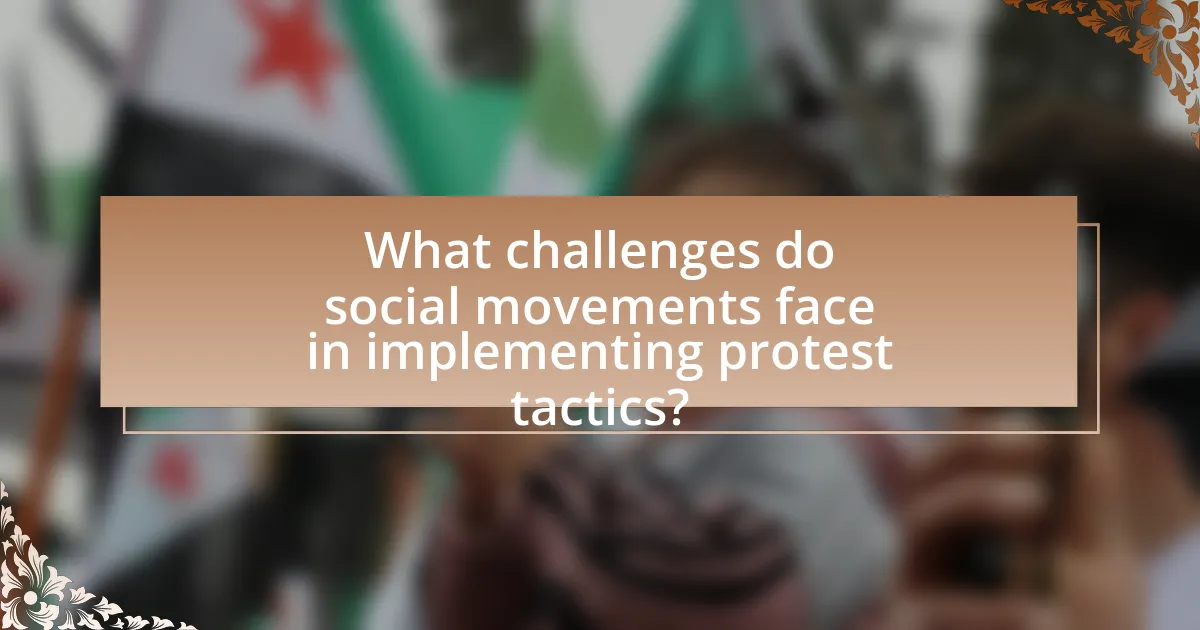
What challenges do social movements face in implementing protest tactics?
Social movements face several challenges in implementing protest tactics, including repression from authorities, internal divisions, and resource limitations. Repression can manifest as police violence, legal repercussions, or surveillance, which can deter participation and escalate tensions. Internal divisions, such as differing ideologies or strategies among members, can lead to conflicts that weaken the movement’s cohesion and effectiveness. Additionally, resource limitations, including funding, access to communication tools, and organizational capacity, can hinder the planning and execution of protests. For instance, the Black Lives Matter movement has encountered significant police resistance during protests, impacting its ability to mobilize effectively.
How do law enforcement responses affect protest tactics?
Law enforcement responses significantly influence protest tactics by shaping the strategies that activists adopt to achieve their goals. When law enforcement employs aggressive tactics, such as the use of tear gas or mass arrests, protesters often adapt by utilizing decentralized organization, nonviolent civil disobedience, or digital mobilization to evade repression. For instance, during the Black Lives Matter protests in 2020, many activists shifted to online organizing and utilized social media to coordinate actions in response to police presence. This adaptability demonstrates that the nature of law enforcement’s response can lead to a transformation in protest methods, as seen historically in various movements where police actions prompted shifts toward more strategic or evasive tactics.
What strategies can movements use to mitigate police repression?
Movements can mitigate police repression by employing strategies such as legal preparedness, community engagement, and nonviolent resistance. Legal preparedness involves training participants on their rights and establishing legal support networks to provide immediate assistance during protests, which has been shown to reduce the likelihood of unlawful arrests. Community engagement fosters solidarity and support, creating a buffer against police actions; for instance, the Black Lives Matter movement has effectively utilized community organizing to build resilience against repression. Nonviolent resistance, exemplified by the tactics used during the Civil Rights Movement, has historically proven to be effective in garnering public sympathy and reducing violent confrontations with law enforcement. These strategies collectively enhance the movement’s ability to navigate and counteract police repression effectively.
How does public perception influence the effectiveness of tactics?
Public perception significantly influences the effectiveness of tactics in social movements by shaping the legitimacy and support for those tactics. When the public views a tactic as justifiable or aligned with societal values, it enhances the movement’s credibility and can lead to increased participation and support. For instance, the Civil Rights Movement in the United States effectively utilized nonviolent protests, which garnered widespread public sympathy and media coverage, ultimately leading to legislative changes. Conversely, tactics perceived as extreme or violent can alienate potential supporters and diminish the movement’s impact, as seen in various protests that faced backlash due to aggressive actions. Thus, public perception acts as a critical determinant in the success or failure of protest tactics.
What are the ethical considerations surrounding protest tactics?
Ethical considerations surrounding protest tactics include the balance between the right to free speech and the potential for harm to individuals or property. Protesters must evaluate whether their methods, such as civil disobedience or property damage, respect the rights of others while effectively conveying their message. For instance, the use of nonviolent tactics, as advocated by leaders like Martin Luther King Jr., is often seen as ethically superior because it minimizes harm and fosters dialogue. In contrast, violent tactics can lead to public backlash and undermine the legitimacy of the cause, as evidenced by the negative perceptions of riots during the 1960s civil rights movement. Thus, ethical protest tactics should prioritize nonviolence, inclusivity, and respect for all individuals involved.
How do movements balance effectiveness with moral implications?
Movements balance effectiveness with moral implications by strategically choosing tactics that align with their ethical values while still achieving their goals. For instance, nonviolent protests, such as those led by Martin Luther King Jr., have historically proven effective in garnering public support and media attention, while also adhering to moral principles of peace and justice. Research indicates that nonviolent movements are more likely to succeed than violent ones, as shown in the study “Why Civil Resistance Works” by Erica Chenoweth and Maria J. Stephan, which analyzed over 300 campaigns from 1900 to 2006. This evidence supports the notion that movements can achieve their objectives without compromising their moral stance, thereby maintaining legitimacy and fostering broader societal support.
What are the potential consequences of using violent tactics?
Using violent tactics can lead to severe consequences, including loss of public support, increased government repression, and escalation of conflict. Historical examples, such as the 1968 Democratic National Convention protests, demonstrate that violent actions can alienate potential allies and shift public perception against a movement. Additionally, research indicates that movements employing violence often face harsher crackdowns from authorities, as seen in the response to the Black Lives Matter protests in 2020, where instances of violence led to intensified police presence and legislative measures against protest activities. Ultimately, the use of violence can undermine the original goals of social movements, diverting attention from their core messages and objectives.
What best practices can enhance the effectiveness of protest tactics?
Effective protest tactics can be enhanced by employing strategic planning, clear messaging, and coalition-building. Strategic planning involves identifying specific goals and target audiences, which increases the likelihood of achieving desired outcomes. Clear messaging ensures that the protest’s objectives are communicated effectively, making it easier for supporters and the general public to understand the cause. Coalition-building fosters alliances with other organizations, amplifying the movement’s reach and resources. Research indicates that movements with strong coalitions, such as the Civil Rights Movement, achieved significant legislative changes, demonstrating the impact of these best practices on effectiveness.
How can social movements effectively mobilize supporters?
Social movements can effectively mobilize supporters by utilizing strategic communication, grassroots organizing, and leveraging social media platforms. Strategic communication involves crafting clear, compelling messages that resonate with potential supporters, as seen in movements like Black Lives Matter, which effectively highlighted systemic racism through powerful narratives. Grassroots organizing builds local networks and fosters community engagement, exemplified by the Women’s March, which mobilized millions through local chapters and community events. Additionally, social media platforms enable rapid information dissemination and community building, allowing movements to reach a broader audience quickly; for instance, the Arab Spring utilized social media to coordinate protests and share real-time updates, significantly increasing participation. These methods collectively enhance visibility, foster a sense of community, and drive collective action among supporters.
What role does coalition-building play in successful protests?
Coalition-building is crucial for successful protests as it enhances collective strength and broadens the base of support. By uniting diverse groups with shared goals, coalitions amplify voices, increase resources, and foster strategic collaboration. Historical examples, such as the Civil Rights Movement, demonstrate that coalitions among various organizations, including churches, labor unions, and student groups, significantly contributed to achieving legislative changes like the Civil Rights Act of 1964. This collaborative approach not only mobilizes larger numbers of participants but also creates a more resilient and adaptable movement capable of addressing complex social issues.
